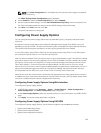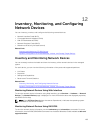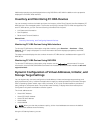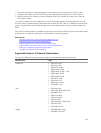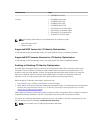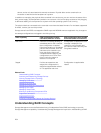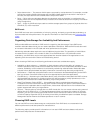
Enabling or Disabling I/O Identity Optimization Using Web Interface
To enable or disable I/O Identity Optimization:
1. In the iDRAC Web interface, go to Overview → Hardware → Network Devices.
The Network Devices page is displayed.
2. Click the I/O Identity Optimization tab, select the I/O Identity Optimization option to enable this
feature. To disable, clear this option.
3. Click Apply to apply the setting.
Enabling or Disabling I/O Identity Optimization Using RACADM
To enable I/O Identity Optimization, use the command:
racadm set idrac.ioidopt.IOIDOptEnable Enabled
After enabling this feature, you must restart the system for the settings to take effect.
To disable I/O Identity Optimization, use the command:
racadm set idrac.ioidopt.IOIDOptEnable Disabled
To view the I/O Identity Optimization setting, use the command:
racadm get iDRAC.IOIDOpt
Configuring Persistence Policy Settings
Using IO identity, you can configure policies specifying the system reset and power cycle behaviors that
determine the persistence or clearance of the virtual address, initiator, and storage target settings. Each
individual persistence policy attribute applies to all ports and partitions of all applicable devices in the
system. The device behavior changes between auxillary powered devices and non-auxillary powered
devices.
You can configure the following persistence policies:
• Virtual Address: Auxiliary powered devices
• Virtual Address: Non-Auxiliary powered devices
• Initiator
• Storage target
Before applying the persistence policy, make sure to:
• Inventory the network hardware at least once, that is, enabled Collect System Inventory On Restart.
• Enable I/O Identity Optimization.
Events are logged to the Lifecycle Controller log when:
• I/O Identity Optimization is enabled or disabled.
• Persistence policy is changed.
• Virtual address, initiator and target values are set based on the policy. A single log entry is logged for
the configured devices and the values that are set for those devices when the policy is applied.
Event actions are enabled for SNMP, email, or WS-eventing notifications. Logs are also included in the
remote syslogs.
199





